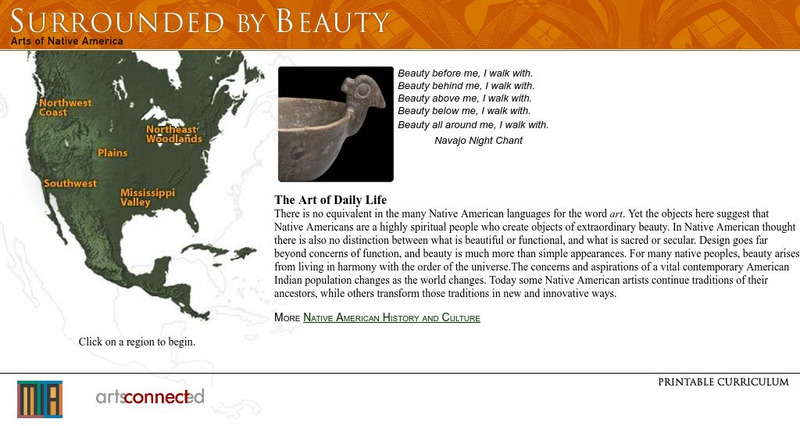A&E Television
History.com: Native American History Timeline
Before Christopher Columbus came to America, the expansive territory was inhabited by Native Americans. Throughout the 16th and 17th centuries, as more explorers sought to colonize their land, Native Americans responded in various...
A&E Television
History.com: Native Americans Weren't Guaranteed the Right to Vote in Every State Until 1962
Native people won citizenship in 1924, but the struggle for voting rights stretched on much longer. Native Americans couldn't be U.S. citizens when the country ratified its Constitution in 1788, and wouldn't win the right to be for 136...
Other
History Today: Native Americans and the Federal Government
Andrew Boxer traces the origins of a historical issue still as controversial and relevant today as in past centuries. At the start of the twentieth century there were approximately 250,000 Native Americans in the USA - just 0.3 per cent...
Henry J. Sage
Sage American History: Native American Cultures: The Pre History of America
Article on pre-Columbian Native American history and culture, including discussion on the impact of the Europeans.
Henry J. Sage
Sage American History: Native American Cultures: Pre History of America
Brief article about Native American culture and history prior to European settlement and with arrival of Europeans.
Khan Academy
Khan Academy: Terms and Issues in Native American Art
Stereotypes persist when discussing Native American arts and cultures, and sadly many people remain unaware of the complicated and fascinating histories of Native peoples and their art. Read examples of these stereotypes and what changes...
Khan Academy
Khan Academy: About Geography and Chronological Periods in Native American Art
So how do you organize so many groups and of such diverse natures when studying Native American art? This article discusses how to organize Native American art by geography and chronology.
Other
Council on Spiritual Practices: A Brief History of the Native American Church
An informative account of the Native American Church in North America and its use of the peyote cactus in its religious services.
Minneapolis Institute of Arts
Minneapolis Institute of Arts: Surrounded by Beauty: Arts of Native America
Explore the art, culture, and history of Native Americans through this Minneapolis Institute of Arts site. You'll find pieces of art from the Northeast Woodlands, Mississippi Valley, Plains, Southwest, and the Northwest coast, as well as...
A&E Television
History.com: History on a Plate: How Native American Diets Shifted After European Colonization
For centuries, Indigenous people's diets were totally based on what could be harvested locally. Then white settlers arrived from Europe. Native people pass down information - including food traditions - from one generation to the next...
A&E Television
History.com: The Native American Origins of Lacrosse
Lacrosse, America's oldest team sport, dates to 1100 A.D., when it was played by the Haudenosaunee, or Iroquois people; it was a social event and sometimes played to settle disputes. The early versions of lacrosse matches played by...
Khan Academy
Khan Academy: Ap Us History: Native American Culture of the Southeast
The dominant Mississippian culture of the Southeast signaled agricultural success and urban development for a variety of Native American groups.
Khan Academy
Khan Academy: Native American Culture of the West
Native American peoples throughout the Western region determined their unique lifestyle by their proximity and abundance of natural resources. This article discusses their food practices, social structures, and religious norms.
Khan Academy
Khan Academy: Native American Culture of the Northeast
Hopewellian culture dominated the Northeast region from 200 BCE to 500 CE, where Native American groups began large-scale three-sister farming. Read more about these tribes and find out why many historians argue that the Iroquois League...
A&E Television
History.com: What Is Indigenous Peoples' Day?
Since 1991, dozens of cities, several universities, and a growing number of states have adopted Indigenous Peoples' Day, a holiday that celebrates the history and contributions of Native Americans. Not by coincidence, the occasion...
Other
Victoriana Magazine: Native American Tribes and u.s Government
The U.S. government's policies towards Native Americans in the second half of the nineteenth century were influenced by the desire to expand westward into territories occupied by these Native American tribes. By the 1850s nearly all...
Other
West Virginia University: A Summary of Native American Religions
This is an excellent introduction to Native American religious beliefs and practices. Includes an explanation of the major Native American Religions and their history. Site is extensive and exclusively text-based.
Hartford Web Publishing
World History Archives: Hartford Web Publishing: The Significance of Wampum
This site contains information about the term Wampum and its significance. Also contains information about Native Americans collecting shells and their worth to the tribe.
Texas State Historical Association
Texas State Historical Association: American Indians in Texas
Looks at the history of Native Americans living in present-day Texas, and the different tribes that have lived there.
A&E Television
History.com: 7 Foods Developed by Native Americans
These seven dietary staples were cultivated over thousands of years by Indigenous peoples of America. While Indigenous diets and foodways were deeply impacted by European settlement, Indigenous American foods also changed the world....
Khan Academy
Khan Academy: Native American Culture of the Southwest
This article discusses the Ancestral Pueblo people who lived in the southwestern region of the modern United States; they constructed elaborate buildings and began the American farming tradition.
Khan Academy
Khan Academy: Us History: 1800 1848: The Presidency of Andrew Jackson
Andrew Jackson was the president for the common man. Under his rule, American democracy flourished as never before- but the economy and the Native American population suffered at his hands.
Khan Academy
Khan Academy: Us History: 1865 1898: Indian Wars/ Battle of the Little Big Horn
In the late nineteenth century, the US Army clashed with Native Americans, and General Custer took his last stand.
Khan Academy
Khan Academy: Us History: 1865 1898: The Dawes Act
The 1887 law intended to assimilate Native Americans led to the loss of millions of acres of land.

















